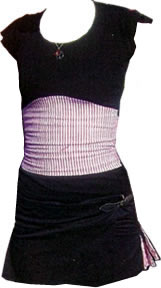Roller Derby Uniform

Ischtar
Wellington High School
Year 13 Fashion and Textiles Technology
Teacher: Kylie Merrick
The Richter City Roller Derby team wanted a uniform that would show the fun of this sport, which has recently been introduced to New Zealand, and reflect their view of the "strong, sexy" women involved in it. Team-member Ischtar developed a prototype outfit, with a view to mass production if it were accepted as the official uniform.
Roller derby is a full-contact sport, so the main specifications for the uniform were durability, safety (decorations such as buckles shouldn't pose a risk to other players) and compliance with the international governing body's regulations. Ischtar identified her key factors as timing (with an August deadline), cost, ergonomics and uniqueness – she wanted it to stand out from other league uniforms.
Ischtar researched current trends in clothing styles, and looked at existing roller derby uniforms. She also researched Wellington city 'icons' that might provide inspiration for her design. Ischtar consulted her clients (the whole team) and discussed her ideas with them, then surveyed opinions through a written questionnaire in which she asked preferences regarding the style of garment (skirt, dress, or shorts), length, colour, fabric and cost.
Ischtar sketched a varied range of concept ideas, some of which she related to Wellington images, such as the metal nikau palms in Civic Square. She discussed her ideas and the survey results with the Richter City chairperson, and then worked on developing her concept designs. She decided that designing around a theme detracted from creating the ideal garment, and altered her brief. She focussed on a puff-sleeved, corset-backed shirt with a netball skirt, using contrasting fabric for the insides of the pleats.
For her final design Ischtar incorporated a fitted shirt, with cuff sleeves and a corset panel which laced at the back, together with a wrap-around netball-type skirt. She researched and costed suitable fabrics, constructed a colour chart, and presented her ideas to the Richter City design committee. They approved Ischtar's design and conferred creative control of fabric and colour choice to her.
Ischtar adapted a pattern for the shirt, and constructed a mock-up in leftover black cotton. She chalked measurements for the corset feature on this, using the markings as a guide to make a pattern. Deciding that making a skirt pattern would be too time-consuming, Ischtar worked out the width of the pleats and adapted an existing skirt pattern. Before sewing the skirt, she modelled different pleating options, to find the most effective method.
Ischtar says the biggest challenge when constructing the ribbed merino shirt was sewing the corset section, which required a six-layer-thick seam. She was concerned that this would look bulky and be irritating to the wearer, so trialled different types of seams. She chose a French seam as being most suitable to hide the layers and as it had the added advantage that it strengthened the seam.
Roller derby attire is more than just functional – players wear makeup and clothing to complement their 'skate' names. Ischtar created a stencil font which she hoped would give the industrial look of a wharf city when she screen-printed her skate name "Miss Skellington" on the front – she notes that cracks in the paint could be seen to reflect the cracked paint on some of the ships in port. Ischtar finished the shirt by embroidering the player's number on the sleeves.
Ischtar had selected a wrap-around skirt as easier for mass production, but topstitched it to achieve a punk rather than a netball look. She made this in black drill and used the striped corset material for the insides of the pleats. Instead of using buttons, as in her original design, Ischtar chose a buckle as more appropriate for the look she wanted and because the skirt could more easily fit a variety of sizes.
The completed uniform was tested when Ischtar wore it to a training session, and she concluded that it was comfortable to wear, noting that the merino top provided warmth before exercise but remained cool and dry during the session. She assessed its condition before and after washing, and found the fabric and accessories suitably durable. Ischtar received positive feedback from her fellow team-members, with comments on how they liked the bold and eye-catching design, and that it would be flattering to most body types.
Teacher comment
The client and brief was unique and challenging. Roller derby is a relatively new sport in New Zealand and the team uniform strongly reflects the creative and diverse individuals who play. Ischtar found that having the team committee as a client meant she had many different individual styles and opinions to work with rather than those of one or two main people. This was a valuable opportunity to expand on her communication, presentation, and people skills, although this did at times make it challenging. There were a range of restrictions and code regulations that needed to be incorporated within the boundaries of the possible solution, and these were not negotiable as they were national and international rules. This meant that there were tight margins to work with in some areas of the project, although this was balanced with endless possible aesthetic looks. Ischtar worked methodically and did a great deal of testing, both in the classroom and on the rink, to ensure that the best decisions were made regarding style, size, materials, fit, length, and comfort. The end solution and prototype exceeded the original guidelines set out by the committee and they were all very happy to have it put into production.






